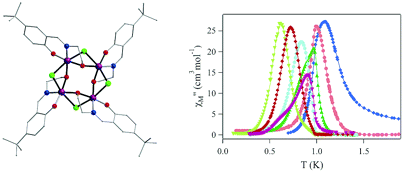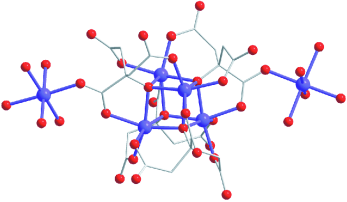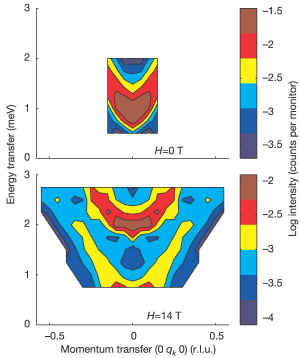Research
Highlights 2003
 Colette Boskovic, Roland Bircher, Philip L. W. Tregenna-Piggott, Hans U. Güdel, Carley Paulsen, Wolfgang Wernsdorfer,
Anne-Laure Barra, Eugene Khatsko, Antonia Neels and Helen Stoeckli-Evans
Colette Boskovic, Roland Bircher, Philip L. W. Tregenna-Piggott, Hans U. Güdel, Carley Paulsen, Wolfgang Wernsdorfer,
Anne-Laure Barra, Eugene Khatsko, Antonia Neels and Helen Stoeckli-Evans
Ferromagnetic and Antiferromagnetic Intermolecular Interactions in a New Family
of Mn4 Complexes with an Energy Barrier to Magnetization Reversal
J. Am. Chem. Soc. 125, 14046-14058 (2003)
![]()
![]()
![]()
![]()
![]()
![]()
![]()
Abstract:
A new family of tetranuclear Mn complexes
[Mn4X4L4] (H2L =
salicylidene-2-ethanolamine; X = Cl (1) or Br (2)) and
[Mn4Cl4(L')4] (H2L' =
4-tert-butyl-salicylidene-2-ethanolamine, (3)) has been
synthesized and studied. Complexes 1-3 possess a square-shaped
core with ferromagnetic exchange interactions between the four MnIII
centers resulting in an S = 8 spin ground state. Magnetochemical studies
and high-frequency EPR spectroscopy reveal an axial magnetoanisotropy with
D values in the range -0.10 to -0.20 cm–1 for
complexes 2 and 3 and for differently solvated forms of 1.
As a result, these species possess an anisotropy-induced energy barrier to
magnetization reversal and display slow relaxation of the magnetization, which
is observed as hysteresis for 1 and 3 and frequency-dependent
peaks in out-of-phase AC susceptibility measurements for 3. The effective
energy barrier was determined to be 7.7 and 7.9 K for 1 and 3,
respectively, and evidence for quantum tunneling of the magnetization was
observed. Detailed magnetochemical studies, including measurements at ultralow
temperatures, have revealed that complexes 1 and 2 possess
solvation-dependent antiferromagnetic intermolecular interactions. Complex
3 displays ferromagnetic intermolecular interactions and approaches a
ferromagnetic phase transition with a critical temperature of ~1 K, which is
coincident with the onset of slow relaxation of the magnetization due to the
molecular anisotropy barrier to magnetization reversal. It was found that the
intermolecular interactions have a significant effect on the manifestation of
slow relaxation of the magnetization, and thereby, these complexes represent a
new family of "exchange-biased single-molecule magnets", where the exchange bias
is controlled by chemical and structural modifications.
 Mark Murrie, Simon J. Teat, Helen Stoeckli-Evans and Hans U. Güdel
Mark Murrie, Simon J. Teat, Helen Stoeckli-Evans and Hans U. Güdel
Synthesis and Characterization of a Cobalt(II) Single-Molecule Magnet
Angew. Chem. 115, 4801-4804 (2003)
![]()
![]()
Angew. Chem. Int. Ed. 42, 4653-4656 (2003)
![]()
![]()
Abstract:
(Article without Abstract)
Graphical Abstract:
Small and attractive: The proligand citric acid has been used to
assemble a new anionic hexanuclear cobalt(II) cluster (see
picture). The complex displays single-molecule magnet (SMM) behavior, with an
energy barrier to the reorientation of magnetization of 26 K, the highest value
to have been recorded for a non-manganese based SMM.
 Mikhail Sofin, Hans-Ulrich Güdel, Roland Bircher, Eva-Maria Peters and Martin Jansen
Mikhail Sofin, Hans-Ulrich Güdel, Roland Bircher, Eva-Maria Peters and Martin Jansen
Na10Co4O10, an Oligooxocobaltate(II, III) with Unusual Magnetic Properties
Angew. Chem. 115, 3651-3653 (2003)
![]()
![]()
Angew. Chem. Int. Ed. 42, 3527-2529 (2003)
![]()
![]()
Abstract:
(Article without Abstract)
Graphical Abstract:
The novel mixed-valent oligooxocobaltate
can be synthesized through a direct
reaction by the azide/nitrate route. The
magnetic properties of the compound are
characterized by the strongly distinct
hierarchy in the magnetic exchange interactions
within the complex anion (see
picture).
 Stephan Heer, Olaf Lehmann, Markus Haase and Hans-Ulrich Güdel
Stephan Heer, Olaf Lehmann, Markus Haase and Hans-Ulrich Güdel
Blue, Green, and Red Upconversion Emission from Lanthanide-Doped LuPO4 and YbPO4
Nanocrystals in a Transparent Colloidal Solution
Angew. Chem. 115, 3288-3291 (2003)
![]()
![]()
Angew. Chem. Int. Ed. 42, 3179-3182 (2003)
![]()
![]()
Abstract:
(Article without Abstract)
Graphical Abstract:
Light converter: The emission of visible
light (Vis) upon excitation in the nearinfrared
(NIR) has been observed for the
first time in a transparent solution. Excitation
at 975 nm (marked red in the
picture) of optically clear colloidal solutions
of LuPO4:Yb3+, Tm3+, and
YbPO4:Er3+ nanocrystals in chloroform
leads to visible upconversion luminescence
in the blue, green, or red spectral
regions.
 Ch. Rüegg, N. Cavadini, A. Furrer, H.-U. Güdel, K. Krämer, H. Mutka, A. Wildes, K. Habicht and P. Vorderwisch
Ch. Rüegg, N. Cavadini, A. Furrer, H.-U. Güdel, K. Krämer, H. Mutka, A. Wildes, K. Habicht and P. Vorderwisch
Bose–Einstein condensation of the triplet states in the magnetic insulator TlCuCl3
Nature 423, 62-65 (2003)
![]()
![]()
Abstract:
Bose–Einstein condensation denotes the formation of a collective quantum ground
state of identical particles with integer spin or intrinsic angular momentum. In
magnetic insulators, the magnetic properties are due to the unpaired shell
electrons that have half-integer spin. However, in some such compounds
(KCuCl3 and TlCuCl3), two Cu2+ ions are
antiferromagnetically coupled to form a dimer in a crystalline network: the
dimer ground state is a spin singlet (total spin zero), separated by an energy
gap from the excited triplet state (total spin one). In these dimer compounds,
Bose–Einstein condensation becomes theoretically possible. At a critical
external magnetic field, the energy of one of the Zeeman split triplet
components (a type of boson) intersects the ground-state singlet, resulting in
long-range magnetic order; this transition represents a quantum critical point
at which Bose–Einstein condensation occurs. Here we report an experimental
investigation of the excitation spectrum in such a field-induced magnetically
ordered state, using inelastic neutron scattering measurements of
TlCuCl3 single crystals. We verify unambiguously the theoretically
predicted gapless Goldstone mode characteristic of the Bose–Einstein
condensation of the triplet states.
![]() Full Text PDF-Files are only accessible from within the University of Bern
Full Text PDF-Files are only accessible from within the University of Bern